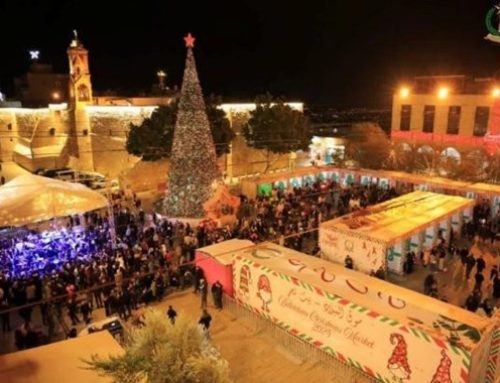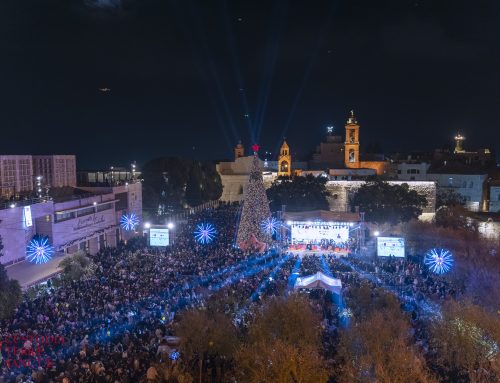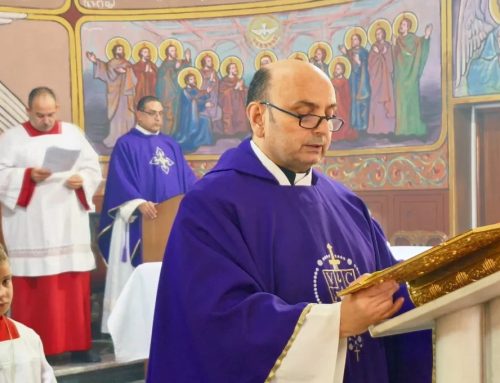In Syria’s northeast, in Qamishli, al-Hasakah, and other cities and their surrounding villages, a renaissance is under way in the area’s beleaguered Syriac Christian community, which is attempting to revive the Syriac language and culture after decades of neglect and oppression. Syria’s Christian community as a whole has suffered immensely during the ongoing eight-year conflict, and the country’s Syriac minority is no exception. The conflict has, however, also brought about social changes that previously would have been thought impossible, particularly in areas under control of the Kurdish-led Syrian Democratic Forces (SDF). Escalating its threat to invade the area despite the presence of American, British, and French troops, Turkey could reverse these changes and even jeopardize the continued existence of the Christian community there.
Syria’s northeast, beyond the Euphrates River, falls into al-Jazira, a region that extends into Turkey and Iraq. Historically, this was Upper Mesopotamia, a patchwork of ethnicities and religions. The various groups here have preserved their unique languages and cultures in the face of decades of Arabization. Kurdish, Syriac, Armenian, Turkish, and other languages, as well as Arabic, are spoken in their respective communities, making the area distinct from other parts of Syria, where Arabic is spoken almost exclusively. Arabic as the country’s official language is imposed nationwide in schools, the government, and the media.
Fast-forward to 2011 and the beginning of the Arab Spring, when Syrians in the northeast region, like those elsewhere, began speaking out for freedom and democracy. Peaceful protests gave way to an armed insurgency, and the government in Damascus eventually withdrew from most of Syria’s northeast, leaving the area to the Kurdish YPG (People’s Protection Units) and allied groups, including the Christian-led Syriac Military Council. Chaos engulfed the country as ISIS and other radical groups made advances on areas that the government had abandoned. In 2015, also in the northeast, the Assyrian Christian villages of the Khabur River valley were overrun by ISIS, which kidnapped over 200 people and held them for a year, until millions of dollars raised by the Assyrian community were paid as ransom to ISIS; the exact amount was never disclosed. Three were killed before the ransom was paid, and one girl never returned. She is believed to have been married off to an ISIS member.
Similar events, including ISIS’s siege of Kobani, a Kurdish-majority city in northern Syria, and of the Yazidi-majority area of Sinjar, Iraq, prompted the formation of a U.S.-led coalition to defeat ISIS, which includes the United Kingdom, France, and other U.S. allies. In Syria, the Kurdish-led YPJ (Women’s Defense Units) and YPG and the Christian-led Syriac Military Council joined with other groups to form the Syrian Democratic Forces (SDF). Together, the SDF and the coalition, the former on the ground and the latter in the air, moved to retake territory that ISIS had captured throughout northern Syria.
The SDF succeeded in retaking territory from ISIS, but it then had the responsibility of governing. To that end, local leaders formed the Autonomous Administration, which governs the areas of Syria under the SDF’s control. The government of Syria does not recognize the region as autonomous.
One of the most notable changes brought about by the Autonomous Administration has been recognition of the rights of the non-Arab peoples of northeastern Syria. Whereas before Arabic was the language used exclusively in almost all public spaces there, now Kurdish and Syriac, as well as Arabic, and sometimes Turkish, are used on local official signage and in documents. To an outsider this may seem insignificant, but it is a serious challenge to the underlying ideology that has governed Syria since its independence in 1946. For the Syriac-speaking Christians of northeast Syria, this could be the key to the community’s survival and revival, its proponents say.
Before the Christian era, the dominant language of the Middle East was Aramaic, a Semitic language related to Hebrew and Arabic. The lingua franca of vast swathes of present-day Syria, Lebanon, Turkey, and Iraq, Aramaic was spoken by Jesus himself in first-century Galilee and Judea. As the region adopted Christianity, the dialect of Aramaic spoken in Edessa (Sanliurfa in present-day Turkey) came to be known as “Syriac” and became the standard written language throughout the region. While Greek dominated early Christian scholarship farther west, Syriac was the language of learning, culture, and religion to the east. With the advent of Islam, however, Syriac lost its place to Arabic even among many Christians and survived as a spoken language in just a few small pockets of the Middle East. Genocide in Turkey against the Syriac, Armenian, and Greek communities in 1915 and 1916 reduced the Syriac presence in the region even further, and many Christians who spoke the language fled to Syria.
By the 1960s, Syrian political leadership had turned against the presence of non-Arab traditions and histories. While Syriac Christians continued to speak their language among themselves, it was not allowed as a secular language of instruction, and its place in the public sphere was limited to religious services. Few people could read it well, as school was taught entirely in Arabic, save for religion class, in which rudimentary Syriac was taught. The language was in peril of extinction. In 2011, in the spirit of the Arab Spring, many Syriac Christians saw an opportunity to revive their language.
Building on the principle that an all-encompassing movement is needed to preserve the community, Syriac organizations centered around the Syriac Union Party have emerged, dedicated to culture, education, women, humanitarian aid, and security. Not all Christians in the northeast back this movement, and many, probably most, have continued to side with the Syrian government, which still controls parts of Qamishli and al-Hasakah. But the movement is far from insignificant. It is tied to the ascendant power in the area, the Kurdish-led SDF, and even many of its Syriac Christian critics can sympathize with the desire to revive Syriac culture and identity. On a trip to northeast Syria in early April, I met many Christians who back the movement. They face significant challenges, not least of which is that many in their own community see them as the token Christian face of a Kurdish nationalist movement, puppets used to gain international support.
Those who publicly support the movement make themselves enemies of the state and risk retribution if the Syrian government ever takes back control of the area, which seemed likely after President Trump announced America’s withdrawal. That decision, since reversed, likely would have forced the SDF to allow the government back into the northeast to fend off a Turkish invasion, and the Syrian government does not take kindly to those who publicly oppose it. Right now the only sure protection is that American, British, and French troops prevent the Syrian government, and Russia, from invading the area and taking it back, which is President Bashar al-Assad’s stated intention. In a televised speech in February, Assad said, in reference to American troops in Syria, that “every inch of Syria will be liberated, and any intruder is an enemy.” In response to Turkey’s renewed threats to invade the area, the Trump administration has worked to assuage Ankara’s concerns over border security and, at the same, to maintain good relations between the United States and the SDF, our primary ally in defeating ISIS in Syria.
Contention has surrounded the question of which curriculum to use in private Christian schools operating in areas under the control of the Autonomous Administration. Rejecting the Arab chauvinism and Baathist propaganda of the official Syrian curriculum, officials in Syria’s northeast have replaced it with one geared toward teaching students in their native language, be it Kurdish, Syriac, or Arabic, and teaching them the history of their different ethnicities.
Last fall, in Qamishli and elsewhere, protests broke out against the imposition of the new curriculum. Critics, including church officials and other area Christians, contended that, because the curriculum is not recognized outside this part of Syria, it will hinder students from being able to study at universities in Syria or abroad. In a statement released on August 18, 2018, “Church leaders and priests in the al-Jazira and the Euphrates” refused “any attempts to impose permits or curricula on schools belonging to the churches, since they are legitimate and legal schools.” The statement came out of a meeting held that day at the Syriac Orthodox bishop’s office in Qamishli, but no names were attached to the statement, leading supporters of the Autonomous Administration to say that their critics were attempting to speak in the name of all clergy in the area.
Critics miss the point, say the curriculum’s supporters, including Jilanos Eissa of the organization Olaf Taw, which developed the Syriac version of the curriculum. Syriac identity is at risk, he points out. For there to be another Mar Ephrem, a prominent Syriac polymath of the fourth century, Syriac children need to learn their own language and be capable of expressing themselves in it. Students would still be taught Arabic, along with Kurdish. Olaf Taw is training teachers in the hope of creating a new generation of Syriac speakers. And interest in the language extends beyond the Syriac community: Four Arabs and three Kurds training to be Syriac teachers recently completed their program with Olaf Taw.
Following the protests and the ensuing international media attention, a compromise was reached to maintain the Arabic-language Syrian-government curriculum in private Christian schools but add two subjects in Syriac, in grade one and in grade two. While the new curriculum was portrayed as anti-Christian in the media, it was actually developed by and for Christians. In the final compromise, only Christian institutions have been allowed to keep the Syrian-government curriculum; all other schools under the control of the Autono-mous Administration must use the new curriculum. That many Syriac Christians oppose this change is a source of frustration to its proponents. It is not only Christians, however, who have opposed the new curriculum, and many Kurdish and Arab parents in the area have left their children in the government-run schools in Qamishli and al-Hasakah out of similar concerns.
Like Olaf Taw, the Syriac Cultural Association in Syria works to promote Syriac culture and strengthen cultural ties in the region through lectures, conferences, and poetry readings involving the Kurdish and Arab communities. Hanna Hanna, who leads the organization’s branch in the city of Qamishli, wants Syriacs to celebrate their ancient history and its achievements once again and to use it in the creation of new music, art, and literature. In its heyday, before the advent of Islam, the Syriac community ran more than 50 schools across Mesopotamia. Their rounded curricula included theology. Hanna sees the Syriac community as distinguished by the importance it has given to education.
The Syriac Military Council and others who have fought against extremists, including ISIS, since 2011 feel that they have won their own freedom with no help from the government. No matter what outcome the war brings, they will not accept a return to the status quo ante bellum. In the town of Tell Tamer, I spoke with Aram Hanna and Abgar Daoud of the Syriac Military Council about the future of the area. In 2015, the Khabur River formed a frontline with ISIS, and an ISIS suicide bomber attempted to break through the lines of the Syriac Military Council at the bridge leading into the town. The Council and its Kurdish allies were able to prevent ISIS from taking the town. Both men left their university studies to defend their people, Aram Hanna tells me. He was studying English literature; Daoud, agricultural engineering. Because they have joined an organization that the Syrian government considers illegal, they are unlikely ever to study again at a university in Syria.
“These four or five years that we’ve lived through, whether our resistance in Raqqa, our resistance in Kobani, our resistance in Ras al-Ayn,” Aram Hanna says, “all that effort — I can’t allow it to all be for nothing. . . . We’re not saying that the solution is a military one. We’re not saying that today the only solution with the regime is war. Our arms are open [to the regime]. But for the region to go back to what it was in 2008, 2007: absolutely not.”
Looking up at photos of those killed fighting for the Syriac Military Council, Aram Hanna continues: “If you look up at those, you’re embarrassed with yourself. . . . That alone gives you an incentive to continue, to defend yourself and defend your cause.” He says that any of those whose pictures hang on the wall would, if he were alive today, support this new project. “The regime accuses us of being separatists, but our goal is not to create a state within a state. The idea is to let each area govern itself.”
As for the future of Syria, Aram Hanna says, “I am a Syriac Syrian, not an Arab Syrian. I have no problem with my Syrianness. My problem is with the Arabism that was forced upon us. I am not Arab. There are Kurds, Turkmen, Armenians, Syriacs, etc. Why don’t we give these people a place? I’m not against my Syrianness. . . . Syria is for all of us and doesn’t belong just to Assad. . . . Kurds didn’t even have Syrian IDs. They weren’t allowed to speak Kurdish.” In 1962, the Syrian government passed a law that stripped many Kurds of their Syrian citizenship, and they have lived as stateless residents of Syria since. In 2011, President Assad restored citizenship to many Kurds, but most felt it was 50 years too late.
The Autonomous Administration has drawn sharp criticism, particularly from Christians who say that the Syriacs are pawns in a Kurdish-nationalist project. But Daoud sees the Autonomous Administration as larger than any one nationalism. He says:
Today we are working on a project. The project is bigger than just providing security for the area and protecting it. We are working on building a new Syria. There are people who benefit from the old project. There are people who are ignorant of politics as a result of what we went through before. And they use this ignorance. Anyone I talk to about the general idea of the Autonomous Administration, democracy, or pluralism finds the idea convincing. But how can [opponents] change that conviction? They say this is a Kurdish project, this is Kurdistan. And someone who is not Kurdish will say, “Why would I work for Kurdistan? Were we not living in Arabistan before, where everything is Arab? Why would I trade that for Kurdistan? At least the thing I was living [in] before, I know it, I know how to operate in it.” This argument is the only thing that can stop the idea [of a multinational Autonomous Administration] from spreading.
Inevitably, this project seeking to upend 50 years of Arab-nationalist domination is not without problems between communities. The curriculum issue has been one of the most visible, but other issues exist as well. Last Christmas the Syriac Orthodox bishop for northeastern Syria, Maurice Amseeh, accused the SDF of digging a tunnel underneath the Christian cemetery in Qamishli. Regarding these and other difficulties, Daoud says, “We’re not saying there aren’t problems. It’s a new system being set up. It’s natural for there to be problems and mistakes. But this understanding exists, that we are more than one people. There’s not just one people in the area, whether they’re Kurds, Arabs, Turkmen, Armenians, or Syriacs. Each people in the area deserves its rights.” Aram Hanna adds that people in other parts of Syria are under the false impression that the area is ruled by a Kurdish authority.
And even if those on the outside see the Autonomous Administration as a Kurdish project, those inside it say that the Syriac Christian community has a say in its political future for the first time in modern history. Syriac Christians will teach their children their ancestral language, the native tongue of Jerusalem, where the church was born.
Will the project last? The answer to that, in the short term at least, probably depends on decisions made thousands of miles away, in Washington. As long as U.S. and allied troops remain in the area, the Autonomous Administration will continue to govern the areas of Syria east of the Euphrates. And if the United States were to withdraw? No one knows. The Syrian government wants to reassert its authority in the region, by force if necessary, and Turkey says it wants to eliminate the Kurdish “terrorists” who are the backbone of this project. When President Trump on December 19 of last year announced that the United States would withdraw from Syria, many predicted the end of the Autonomous Administration. But now that decision has been reversed, and Syriac Christians who are tired of war have reason to hope that the United States will not abandon those with whom it defeated ISIS in northeast Syria. A Turkish invasion, as threatened by that country’s president, could put the faith that they have put in the United States to the test.






